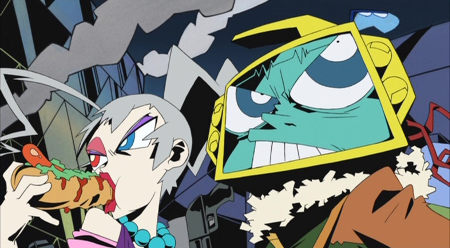
DIRECTED BY: Gregg Araki
FEATURING: Rose McGowan, James Duval, Johnathon Schaech
PLOT: Three teenagers have sex and go on a murder spree.

WHY IT WON’T MAKE THE LIST: With lots of low-comedy shocks but very little outright weirdness, The Doom Generation is a shallow, unilluminating wallow in hyperironic misery. The best thing I can say about this movie is that it makes Akari’s followup, Nowhere, seem mature and clever by comparison.
COMMENTS: The main characters are a slut, an idiot, and a psycho. It’s never a good sign when the audience hates all three of the principals and hopes that they will die. Instead, the trio kill a bunch of people who are probably as loathsome as they are—but we never get the chance to find out for sure, because we’re stuck following these losers on their tour of American convenience stores and motel rooms. The only possible reason to like these characters would be the Bonnie-and-Clyde affair between Amy and Jordan, but Araki sabotages that possibility by making the male a spineless cuckold, and granting the female’s selfish fantasy of banging the bad boy while keeping her sweet doting lover on the side. Meanwhile, there’s nothing at all redeemable about third-wheel Xavier, who exists only to seduce these two lost souls into a life of slaughter that, we assume, is meant to play as their logical reaction to the superficial consumerist society they find themselves trapped in.
The Doom Generation is a painfully tone-deaf satire that tries for the trashy camp of John Waters, but actually has the comic sensibilities of Dude, Where’s My Car? To wit: the decapitated Asian Quickiemart clerk’s name is—get this—“Nguyen Kok Suk.” Heh heh, brilliant: pass that bong, brah. I suppose the meta-joke is supposed to be that Araki is crafting a movie that’s so dumb that his characters—kids given to uttering self-pitying lines like “there’s just no place for us in this world”—would think was deep. A newswoman characterizes the skull earring found at a crime scene as “the type sold most frequently in ‘rock and roll’ paraphernalia shops, often worn by homosexuals, Satanists, and members of other dangerous cult groups.” This, of course, is the way clueless teenagers imagine clueless adults talk about them. Araki lays the irony on so thick that we can’t tell whether he’s secretly fond of these kids (whose only good act is to bury a dog they accidentally kill), or is just using them for the sex and murder money shots he needs to keep the audience feeling smug, titillated and jaded.
The characters surnames are Red, White and Blue, and every time they purchase something at a convenience store or drive-thru, the cash register rings up “$6.66.” Is Araki implying that America is hell? I can’t tell. The only good points about the movie are the art direction, Rose McGowan’s performance (a confident debut in her first starring role), and a somewhat amusing running joke where Amy keeps running into old lovers she denies knowing. The only weird points are the severed head that keeps talking after it flies off its body and the green screen news broadcast where vapid talking heads deliver campy copy over grisly crime scene footage. Otherwise, this is a tedious tale of three unpleasant people wandering around and killing things until their movie ends. It should have been titled The Dim Generation.
Lest one I assume I have some personal vendetta against Gregg Araki, note that I gave The Mysterious Skin a “Must See” rating. It’s hard to imagine that that intelligent and emotionally shattering drama, which tackles the subject of youthful disaffection with authenticity and compassion rather than sick jokes, was the work of the same director as the self-consciously hip Doom Generation. The difference in quality results from Araki, a great stylist but not a great thinker, adapting someone else’s material rather than writing his own.
WHAT THE CRITICS SAY:
(This movie was nominated for review by “Eva”. Suggest a weird movie of your own here.)






